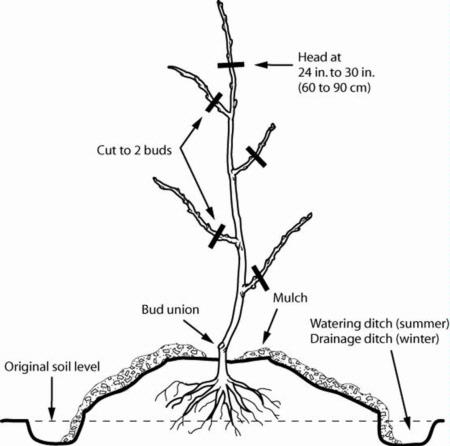Selecting and Planting Bare Root Fruit Trees
Winter is an ideal time to plant a fruit tree. Although it requires some patience, success is best using bare root trees. There are many advantages: the trees are lighter and easier to handle; you can get a good look at the roots; they cost less than leafed-out potted trees; the tree is dormant and less apt to be stressed by handling; and the roots don't have to adapt again to new soil. The main disadvantage is that you should get the tree in the ground within a few days after purchase, and it may take 2–3 years before some trees produce fruit.
Fruit trees are an investment and deserve some thoughtfulness to ensure you plant the right tree (appropriate for your climate zone) in the right location (good drainage, minimum 6 hours sun per day). Digging the planting hole before buying the tree will let you check for drainage and an adequate amount (2–3 feet deep minimum) of soil. Here is a website showing how to test soil including drainage: https://marinmg.ucanr.edu/BASICS/SOIL_813/evaluate/
Selecting a healthy bare root tree is critical to get your investment off to a good start. Buy your tree from a reputable nursery that has a wide selection. You don't want a tree with roots that have been in a container too long. These roots may be kinked and will look like they are circling the root ball. These roots tend not to spread and that deprives your tree of needed nutrients.
When preparing the hole for your tree, follow the steps as described in the article linked below to give the roots room to spread and to prevent the graft site from sinking below soil level. Backfill with native soil. As you can see from the diagram below, most of the root ball should be above the original soil level to avoid crown rot. The tree will also settle.
And unless you want a huge tree with more fruit than most families could possibly eat, prune the trunk back to about knee height after planting. This takes some courage, but your tree will reward you with plenty of fruit that is easy to reach. Wait until the weather will be dry for at least several weeks to prune apricots, apriums, and cherries.
Other considerations are pollination requirements, ultimate tree size, chill hours, and disease susceptibility. Pollination is necessary for good fruit production. Some fruit trees have flowers with both male (anthers) and female (pistils) organs and can self-pollinate, such as persimmons and Bartlett pears. Other trees have flowers with both male and female organs but cannot self-pollinate and will require a second tree planted within 100 feet for fruit production, such as many apple varieties and Asian pears. Still others have separate male and female flowers.
Deciduous fruit and nut trees require a certain number of “chill hours” below 45°F to produce. It is important to select only varieties that have chill hour requirements equal to or lesser than the chill hours listed for your area. This reference discusses chill hours and has links to fruit tree requirements for Contra Costa County: https://ccmg.ucanr.edu/files/77176.pdf
It's important to know which diseases and pests a particular fruit tree is susceptible to. For example, apricots and their crosses such as aprium and pluot are prone to infection by the Eutypa fungus and unlike most deciduous trees, should be pruned in late summer before the weather gets damp. Check the reference below. These references have links and information regarding fertilization, pollination, pests and diseases, and characteristics of various fruit trees.
Despite our recent rains, we are still in a drought. Most fruit trees need substantial amounts of water to become established and as they mature and produce fruit. This link has information about drought tolerant fruit trees, shrubs and vines: https://crfg.org/wp-content/uploads/Drought-Tolerant-Fruiting-Trees-Shrubs-and-Vines-Presentation.pdf
Articles with step-by-step planting guides:
• https://sonomamg.ucanr.edu/Food_Gardening/Additional_KG_Articles/Planting_Bare-root_Fruit_Trees/
• https://ucanr.edu/blogs/blogcore/postdetail.cfm?postnum=46072
• https://ucanr.edu/blogs/blogcore/postdetail.cfm?postnum=38836
Excellent video with step-by-step planting guide (UC does not recommend any particular business but this nursery has good videos and does not advertise its products):
• https://www.youtube.com/watch?v=fP-2TGlNo50
More information:
• The Big Picture: https://homeorchard.ucanr.edu/
• Fruit trees for Contra Costa County – great reference to help you decide what to buy, and a pollinating guide: https://ucanr.edu/sites/ccmg/files/228958.pdf
• Fruit tree pests and diseases: http://ipm.ucanr.edu/PMG/GARDEN/fruit.html
Help Desk of the UC Master Gardener Program of Contra Costa County (EAS)
